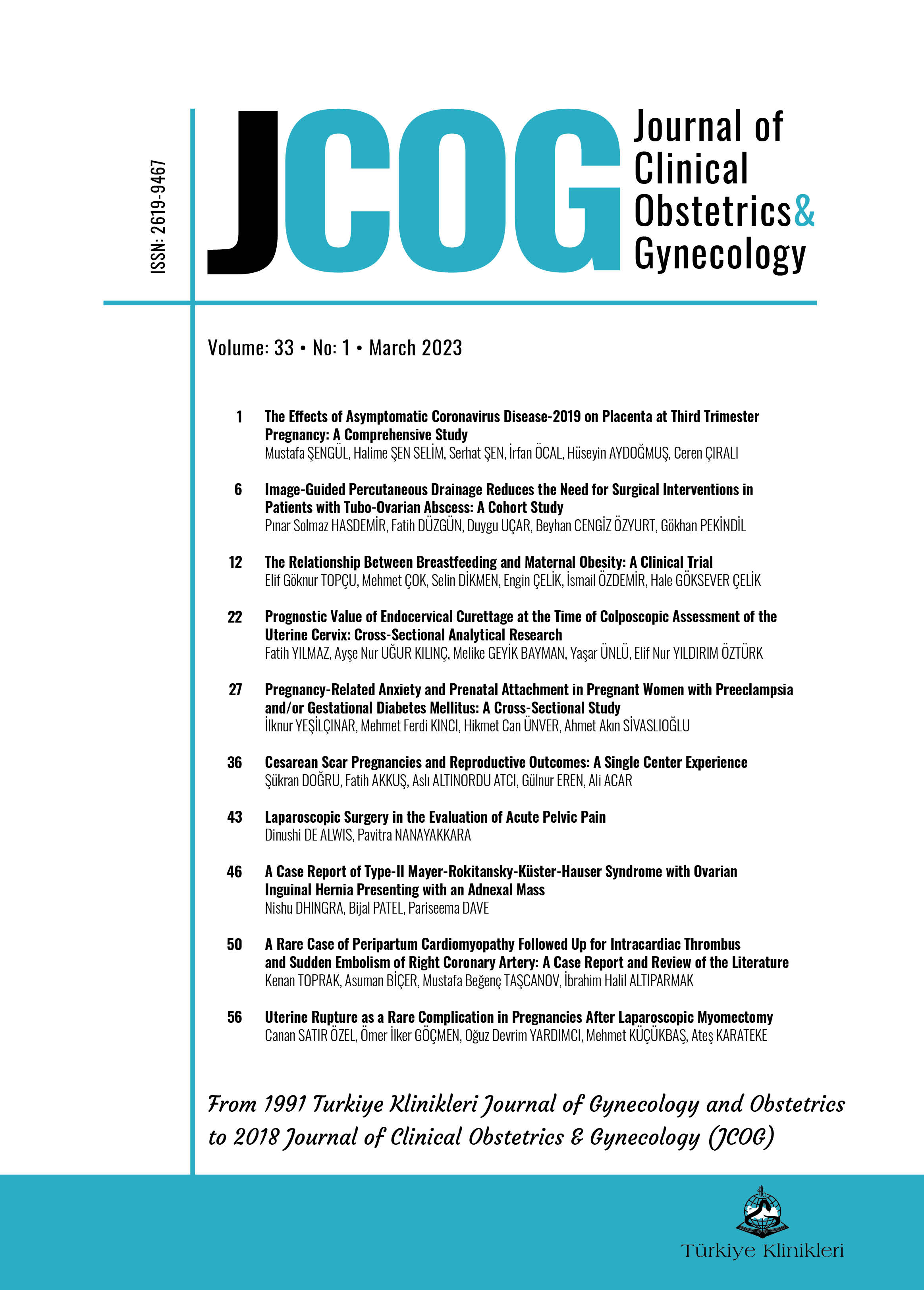Open Access
Peer Reviewed
ORIGINAL RESEARCH
1414 Viewed1062 Downloaded
Prognostic Value of Endocervical Curettage at the Time of Colposcopic Assessment of the Uterine Cervix: Cross-Sectional Analytical Research
Received: 14 Sep 2022 | Received in revised form: 01 Dec 2022
Accepted: 20 Dec 2022 | Available online: 22 Dec 2022
JCOG. 2023;33(1):22-6
DOI: 10.5336/jcog.2022-93046
Article Language: EN
Article Language: EN
Copyright Ⓒ 2025 by Türkiye Klinikleri. This is an open access article under the CC BY-NC-ND license (http://creativecommons.org/licenses/by-nc-nd/4.0/)
ABSTRACT
Objective: This study aimed to investigate the necessity and diagnostic value of endocervical curettage (ECC) in cervical preneoplastic and neoplastic lesions. Material and Methods: A total of 296 patients who were admitted to the gynecologic oncology outpatient clinic at a single tertiary care center and who simultaneously underwent colposcopic biopsy and ECC between 2018 and 2020 were included in the study. Hematoxylin-Eosin (H&E), p16, and ki-67-stained preparations obtained from biopsy and curettage samples of the patients were analyzed by light microscope. Demographic data of the patients were obtained from the hospital system. Results were statistically and comparatively analyzed. Results: Cervical premalignant/malignant lesion was detected in 125 out of 296 patients and premalignant/malignant lesion was detected in 42 patients on ECC. Out of these 42 patients, 19 were diagnosed by ECC material alone. It was striking that all of the 5 HPV-18- positive patients were diagnosed with ECC material. When conization materials of CIN 2-3 patients were assessed with ECC results, it was observed that adenocarcinoma and glandular involvement were remarkably significant in ECC-positive patients. Conclusion: Our study involves important findings in the determination of the role of ECC in diagnosing cervical premalignant lesions. ECC simultaneously performed with colposcopic biopsy for appropriate women increases the diagnosticity of colposcopic biopsy procedure and gives information about glandular involvement. Moreover, it can decrease the risk of recurrence and minimize surgical margins.
Objective: This study aimed to investigate the necessity and diagnostic value of endocervical curettage (ECC) in cervical preneoplastic and neoplastic lesions. Material and Methods: A total of 296 patients who were admitted to the gynecologic oncology outpatient clinic at a single tertiary care center and who simultaneously underwent colposcopic biopsy and ECC between 2018 and 2020 were included in the study. Hematoxylin-Eosin (H&E), p16, and ki-67-stained preparations obtained from biopsy and curettage samples of the patients were analyzed by light microscope. Demographic data of the patients were obtained from the hospital system. Results were statistically and comparatively analyzed. Results: Cervical premalignant/malignant lesion was detected in 125 out of 296 patients and premalignant/malignant lesion was detected in 42 patients on ECC. Out of these 42 patients, 19 were diagnosed by ECC material alone. It was striking that all of the 5 HPV-18- positive patients were diagnosed with ECC material. When conization materials of CIN 2-3 patients were assessed with ECC results, it was observed that adenocarcinoma and glandular involvement were remarkably significant in ECC-positive patients. Conclusion: Our study involves important findings in the determination of the role of ECC in diagnosing cervical premalignant lesions. ECC simultaneously performed with colposcopic biopsy for appropriate women increases the diagnosticity of colposcopic biopsy procedure and gives information about glandular involvement. Moreover, it can decrease the risk of recurrence and minimize surgical margins.
REFERENCES:
- Davey DD, Neal MH, Wilbur DC, Colgan TJ, Styer PE, Mody DR. Bethesda 2001 implementation and reporting rates: 2003 practices of participants in the College of American Pathologists Interlaboratory Comparison Program in Cervicovaginal Cytology. Arch Pathol Lab Med. 2004;128(11):1224-9. [Crossref] [PubMed]
- Wright TC Jr, Cox JT, Massad LS, Twiggs LB, Wilkinson EJ; ASCCP-Sponsored Consensus Conference. 2001 Consensus Guidelines for the management of women with cervical cytological abnormalities. JAMA. 2002;287(16):2120-9. [Crossref] [PubMed]
- Bidus MA, Elkas JC, Rodriguez M, Maxwell GL, Rose GS. The clinical utility of the diagnostic endocervical curettage. Clin Obstet Gynecol. 2005;48(1):202-8. [Crossref] [PubMed]
- Massad LS. Selecting patients for endocervical curettage. J Low Genit Tract Dis. 2015;19(4):271-2. [Crossref] [PubMed]
- Massad LS, Einstein MH, Huh WK, Katki HA, Kinney WK, Schiffman M, et al; 2012 ASCCP Consensus Guidelines Conference. 2012 updated consensus guidelines for the management of abnormal cervical cancer screening tests and cancer precursors. Obstet Gynecol. 2013;121(4):829-46. [Crossref] [PubMed]
- Gage JC, Hanson VW, Abbey K, Dippery S, Gardner S, Kubota J, et al; ASCUS LSIL Triage Study (ALTS) Group. Number of cervical biopsies and sensitivity of colposcopy. Obstet Gynecol. 2006;108(2):264-72. [Crossref] [PubMed]
- Pretorius RG, Zhang WH, Belinson JL, Huang MN, Wu LY, Zhang X, et al. Colposcopically directed biopsy, random cervical biopsy, and endocervical curettage in the diagnosis of cervical intraepithelial neoplasia II or worse. Am J Obstet Gynecol. 2004;191(2):430-4. [Crossref] [PubMed]
- Pretorius RG, Belinson JL, Peterson P, Burchette RJ. Which colposcopies should include endocervical curettage? J Low Genit Tract Dis. 2015;19(4):278-81. [Crossref] [PubMed]
- Song Y, Zhao YQ, Li L, Pan QJ, Li N, Zhao FH, et al. A retrospective analysis of the utility of endocervical curettage in screening population. Oncotarget. 2017;8(30):50141-7. [Crossref] [PubMed] [PMC]
- Lu CH, Liu FS, Kuo CJ, Chang CC, Ho ES. Prediction of persistence or recurrence after conization for cervical intraepithelial neoplasia III. Obstet Gynecol. 2006;107(4):830-5. [Crossref] [PubMed]
- Ganesan R. HPV-related cervical glandular lesions. Diagnostic Histopathology. 2018;24(1):18-25. [Crossref]
MENU
POPULAR ARTICLES
MOST DOWNLOADED ARTICLES





This journal is licensed under a Creative Commons Attribution-NonCommercial-NoDerivatives 4.0 International License.










